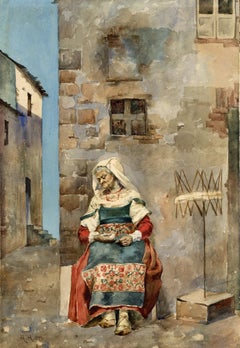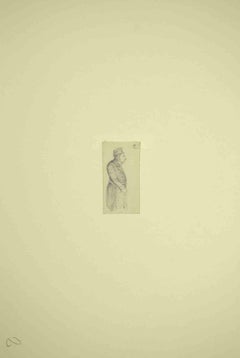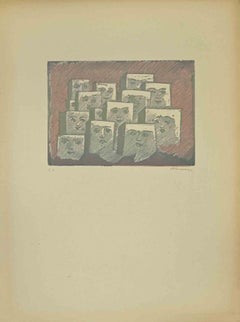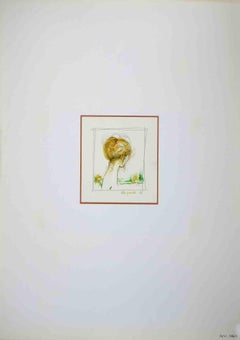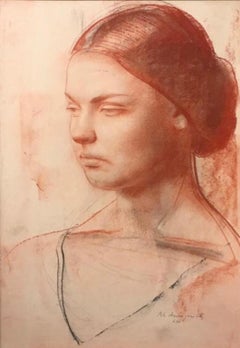Wall Portrait Drawings and Watercolors
to
3
1
Overall Width
to
Overall Height
to
2
2
1
1
2
1
4
1,032
3,443
1,962
1,951
1,659
1,241
716
664
623
496
444
359
143
101
88
83
76
68
58
54
2
2
2
1
1
1
1
1
3
1
Art Subject: Wall
Contemplation
Located in Middletown, NY
This is an engaging work with masterful detail that will unfold for an intent viewer, particularly in the area of the figure's well-worn hands, and her traditional clothing. The image depicts a Bavarian woman deep in thought while winding a skein of wool. She is seated outside of her home, where she has brought her yarn swift...
Category
1870s English School Portrait Drawings and Watercolors
Materials
Watercolor, Handmade Paper
Portraits - Pencil - Late 19th Century
Located in Roma, IT
Portraits is an original drawing in Pencil on paper realized by an anonymous artist in the late 19th Century.
Good conditions but aged.
The artwork represents two portraits on both...
Category
Late 19th Century Modern Portrait Drawings and Watercolors
Materials
Pencil
Faces - Print by Mino Maccari - 1940s
By Mino Maccari
Located in Roma, IT
Faces is a linocut realized by Mino Maccari in the 1940s.
50 x 30 cm.
Handisigned in the lower right part. Edition of 12 copies.
Reference; Cat. Meloni , pag 367, n.1741.
Good c...
Category
1940s Contemporary Portrait Drawings and Watercolors
Materials
Paper, Charcoal, Pastel, Linocut
Portrait from Behind - Drawing by Leo Guida - 1972
By Leo Guida
Located in Roma, IT
Portrait from Behind is an original drawing in ink and watercolor realized by Leo Guida in 1972.
Good condition.
Hand-signed.
Leo Guida (1992 - 2017). Sensitive to current issues...
Category
1970s Contemporary Portrait Drawings and Watercolors
Materials
Ink, Watercolor
Related Items
French Modern Drawing by Jean Hélion - Veil Homme
By Jean Hélion
Located in Paris, IDF
Veil Homme
1947
drawing
26,9 x 21 x 0,1 cm
Registered on the catalogue raisonné with inventory number : N°0252 cat. B
sold without frame
about Jean Hélion (April 21, 1904 – October ...
Category
1960s Modern Figurative Drawings and Watercolors
Materials
Paper, Pencil
'Young lady' on Paper by Pietro Annigoni Painter of Queen Elisabeth 1970
Located in Brescia, IT
This fine and elegant woman portrait in red pastel on paper was drawn by Pietro Annigoni, an Italian artist of the 20th Century called the 'Queen's pa...
Category
20th Century Modern Portrait Drawings and Watercolors
Materials
Carbon Pencil
H 21.66 in W 15.36 in D 1.19 in
Contemporary Drawing "Blue Prayer" Draw, Pastel, Ink And Colored Pencils
Located in Bogotá, Bogotá
Drawing, pastel, Pencil, Petal Flowers, Color and Ink on Paper.
The base of this drawing is ordinary yellow paper of 80 gr. I use natural dyes from flowers, herbs, leaves, and tree ...
Category
2010s Contemporary Portrait Drawings and Watercolors
Materials
Paper, Pastel, Ink, Pencil, Color Pencil
Portrait of a Young Man Original Charcoal and Pastel French 18th Century
Located in London, GB
French School
18th Century
Portrait of a Young Man
Charcoal and pastel on paper
Image size: 11 x 7 inches
Contemporary gilt frame
Category
18th Century Rococo Portrait Drawings and Watercolors
Materials
Paper, Charcoal, Pastel
Duchándome, May 28th, Watercolor Diptych, 2018
Located in Miami Beach, FL
Duchándome, May 28th by Celso Castro-Daza
From the Duchándome Series
Watercolor and ink on an archival paper
Individual size: 19.5 in. H x 13.75 in. W
Sheet Size: 19.5 in. H x 27.5 i...
Category
2010s Contemporary Nude Drawings and Watercolors
Materials
Archival Paper, Archival Ink, Watercolor
H 19.5 in W 27.5 in D 0.1 in
Black Panther Trials - Civil Rights Movement Police Violence African American
Located in Miami, FL
The Black Panther Trials - In this historically significant work, African American Artist Vicent D. Smith functions as an Art Journalist/ Court Reporter as much as a
Artist. Here, he depicts, in complete unity, 21 Black Panther Protestors raising their fist of defiance at the White Judge. Smith's composition is about utter simplicity, where the Black Panther Protestors are symmetrically lined up in a confrontation with a Judge whose size is exaggerated in scale. Set against a stylized American Flag, the supercilious Judge gazes down as the protesters as their fists thrust up. Signed Vincent lower right. Titled Panter 21. Original metal frame. Tape on upper left edge of frame. 255 . Panther 21. Framed under plexi.
_____________________________
From Wikipedia
In 1969-1971 there was a series of criminal prosecutions in New Haven, Connecticut, against various members and associates of the Black Panther Party.[1] The charges ranged from criminal conspiracy to first-degree murder. All charges stemmed from the murder of 19-year-old Alex Rackley in the early hours of May 21, 1969. The trials became a rallying-point for the American Left, and marked a decline in public support, even among the black community, for the Black Panther Party
On May 17, 1969, members of the Black Panther Party kidnapped fellow Panther Alex Rackley, who had fallen under suspicion of informing for the FBI. He was held captive at the New Haven Panther headquarters on Orchard Street, where he was tortured and interrogated until he confessed. His interrogation was tape recorded by the Panthers.[2] During that time, national party chairman Bobby Seale visited New Haven and spoke on the campus of Yale University for the Yale Black Ensemble Theater Company.[3] The prosecution alleged, but Seale denied, that after his speech, Seale briefly stopped by the headquarters where Rackley was being held captive and ordered that Rackley be executed. Early in the morning of May 21, three Panthers – Warren Kimbro, Lonnie McLucas, and George Sams, one of the Panthers who had come East from California to investigate the police infiltration of the New York Panther chapter, drove Rackley to the nearby town of Middlefield, Connecticut. Kimbro shot Rackley once in the head and McLucas shot him once in the chest. They dumped his corpse in a swamp, where it was discovered the next day. New Haven police immediately arrested eight New Haven area Black Panthers. Sams and two other Panthers from California were captured later.
Sams and Kimbro confessed to the murder, and agreed to testify against McLucas in exchange for a reduction in sentence. Sams also implicated Seale in the killing, telling his interrogators that while visiting the Panther headquarters on the night of his speech, Seale had directly ordered him to murder Rackley. In all, nine defendants were indicted on charges related to the case. In the heated political rhetoric of the day, these defendants were referred to as the "New Haven Nine", a deliberate allusion to other cause-celebre defendants like the "Chicago Seven".
The first trial was that of Lonnie McLucas, the only person who physically took part in the killing who refused to plead guilty. In fact, McLucas had confessed to shooting Rackley, but nonetheless chose to go to trial.
Jury selection began in May 1970. The case and trial were already a national cause célèbre among critics of the Nixon administration, and especially among those hostile to the actions of the FBI. Under the Bureau's then-secret "Counter-Intelligence Program" (COINTELPRO), FBI director J. Edgar Hoover had ordered his agents to disrupt, discredit, or otherwise neutralize radical groups like the Panthers. Hostility between groups organizing political dissent and the Bureau was, by the time of the trials, at a fever pitch. Hostility from the left was also directed at the two Panthers cooperating with the prosecutors. Sams in particular was accused of being an informant, and lying to implicate Seale for personal benefit.
In the days leading up to a rally on May Day 1970, thousands of supporters of the Panthers arrived in New Haven individually and in organized groups. They were housed and fed by community organizations and by sympathetic Yale students in their dormitory rooms. The Yale college dining halls provided basic meals for everyone. Protesters met daily en masse on the New Haven Green across the street from the Courthouse (and one hundred yards from Yale's main gate). On May Day there was a rally on the Green, featuring speakers including Jean Genet, Abbie Hoffman, Jerry Rubin, and John Froines (an assistant professor of chemistry at the University of Oregon). Teach-ins and other events were also held in the colleges themselves.
Towards midnight on May 1, two bombs exploded in Yale's Ingalls Rink, where a concert was being held in conjunction with the protests.[4] Although the rink was damaged, no one was injured, and no culprit was identified.[4]
Yale chaplain William Sloane Coffin stated, "All of us conspired to bring on this tragedy by law enforcement agencies by their illegal acts against the Panthers, and the rest of us by our immoral silence in front of these acts," while Yale President Kingman Brewster Jr. issued the statement, "I personally want to say that I'm appalled and ashamed that things should have come to such a pass that I am skeptical of the ability of a Black revolutionary to receive a fair trial anywhere in the U.S." Brewster's generally sympathetic tone enraged many of the university's older, more conservative alumni, heightening tensions within the school community.
As tensions mounted, Yale officials sought to avoid deeper unrest and to deflect the real possibility of riots or violent student demonstrations. Sam Chauncey has been credited with winning tactical management on behalf of the administration to quell anxiety among law enforcement and New Haven's citizens, while Kurt Schmoke, a future Rhodes Scholar, mayor of Baltimore, MD and Dean of Howard University School of Law, has received kudos as undergraduate spokesman to the faculty during some of the protest's tensest moments. Ralph Dawson, a classmate of Schmoke's, figured prominently as moderator of the Black Student Alliance at Yale (BSAY).
In the end, compromises between the administration and the students - and, primarily, urgent calls for nonviolence from Bobby Seale and the Black Panthers themselves - quashed the possibility of violence. While Yale (and many other colleges) went "on strike" from May Day until the end of the term, like most schools it was not actually "shut down". Classes were made "voluntarily optional" for the time and students were graded "Pass/Fail" for the work done up to then.
Trial of McLucas
Black Panther trial sketch...
Category
1970s American Modern Figurative Drawings and Watercolors
Materials
Watercolor, Pen, Pencil, Paper
1940s Charcoal and Pencil Portrait of a Man
Located in Arp, TX
Artist Unknown
"Tie and Glasses"
c. 1940s
Charcoal and pencil on paper
13.5"x17" site 19"x23" rustic wood frame
Unsigned
Category
1940s Modern Portrait Drawings and Watercolors
Materials
Paper, Charcoal, Carbon Pencil
The Roman Bath
Located in London, GB
'The Roman Bath', pencil on art paper (circa 1960s), School of Rome. Three broad-shouldered men make their way through the sultry corridors of the Hammam in...
Category
1960s Modern Nude Drawings and Watercolors
Materials
Paper, Pencil
"Contemplation"
Located in Lambertville, NJ
Jim’s of Lambertville is proud to offer this artwork by:
Gershon Benjamin (1899-1985)
An American Modernist of portraits, landscapes, still lives, and the urban scene, Gershon Benj...
Category
1920s Modern Figurative Drawings and Watercolors
Materials
Graphite
Rare Modernist Hungarian Rabbi Pastel Drawing Gouache Painting Judaica Art Deco
Located in Surfside, FL
Rabbi in the synagogue at prayer wearing tallit and tefillin.
Hugó Scheiber (born 29 September 1873 in Budapest – died there 7 March 1950) was a Hungarian modernist painter.
Hugo Scheiber was brought from Budapest to Vienna at the age of eight where his father worked as a sign painter for the Prater Theater. At fifteen, he returned with his family to Budapest and began working during the day to help support them and attending painting classes at the School of Design in the evening, where Henrik Papp was one of his teachers. He completed his studies in 1900. His work was at first in a post-Impressionistic style but from 1910 onward showed his increasing interest in German Expressionism and Futurism. This made it of little interest to the conservative Hungarian art establishment.
However, in 1915 he met the great Italian avant-gardist Filippo Tommaso Marinetti and the two painters became close friends. Marinetti invited him to join the Futurist Movement. The uniquely modernist style that he developed was, however, closer to German Expressionism than to Futurism and eventually drifted toward an international art deco manner similar to Erté's. In 1919, he and his friend Béla Kádar held an exhibition at the Hevesy Salon in Vienna. It was a great success and at last caused the Budapest Art Museum to acquire some of Scheiber's drawings. Encouraged, Scheiber came back to live in Vienna in 1920.
A turning point in Scheiber's career came a year later, when Herwarth Walden, founder of Germany's leading avant-garde periodical, Der Sturm, and of the Sturm Gallery in Berlin, became interested in Scheiber's work. Scheiber moved to Berlin in 1922, and his paintings soon appeared regularly in Walden's magazine and elsewhere. Exhibitions of his work followed in London, Rome, La Paz, and New York.
Scheiber's move to Germany coincided with a significant exodus of Hungarian artists to Berlin, including Laszlo Moholy-Nagy and Sandor Bortnyik. There had been a major split in ideology among the Hungarian avant-garde. The Constructivist and leader of the Hungarian avantgarde, Lajos Kassák (painted by Hugó Scheiber in 1930) believed that art should relate to all the needs of contemporary humankind. Thus he refused to compromise the purity of his style to reflect the demands of either the ruling class or socialists and communists. The other camp believed that an artist should be a figurehead for social and political change.
The fall out and factions that resulted from this politicisation resulted in most of the Hungarian avant gardists leaving Vienna for Berlin. Hungarian émigrés made up one of the largest minority groups in the German capital and the influx of their painters had a significant effect on Hungarian and international art. Another turning point of Scheiber's career came in 1926, with the New York exhibition of the Société Anonyme, organized by Katherine Dreier. Scheiber and other important avant garde artists from more than twenty-three countries were represented. In 1933, Scheiber was invited by Marinetti to participate in the great meeting of the Futurists held in Rome in late April 1933, Mostra Nazionale d’Arte Futurista where he was received with great enthusiasm. Gradually, the Hungarian artists began to return home, particularly with the rise of Nazism in Germany. Kádar went back from Berlin in about 1932 and Scheiber followed in 1934.
He was then at the peak of his powers and had a special flair in depicting café and cabaret life in vivid colors, sturdily abstracted forms and spontaneous brush strokes. Scheiber depicted cosmopolitan modern life using stylized shapes and expressive colors. His preferred subjects were cabaret and street scenes, jazz musicians, flappers, and a series of self-portraits (usually with a cigar). his principal media being gouache and oil. He was a member of the prestigious New Society of Artists (KUT—Képzőművészek Új Társasága)and seems to have weathered Hungary's post–World War II transition to state-communism without difficulty. He continued to be well regarded, eventually even receiving the posthumous honor of having one of his images used for a Russian Soviet postage stamp (see image above). Hugó Scheiber died in Budapest in 1950.
Paintings by Hugó Scheiber form part of permanent museum collections in Budapest (Hungarian National Museum), Pecs (Jannus Pannonius Museum), Vienna, New York, Bern and elsewhere. His work has also been shown in many important exhibitions, including:
"The Nell Walden Collection," Kunsthaus Zürich (1945)
"Collection of the Société Anonyme," Yale University Art Gallery, New Haven, Connecticut (1950)
"Hugó Scheiber: A Commemorative Exhibition," Hungarian National Museum, Budapest (1964)
"Ungarische Avantgarde," Galleria del Levante, Munich (1971)
"Paris-Berlin 1900-1930," Centre Georges Pompidou, Paris (1978)
"L’Art en Hongrie, 1905-1920," Musée d’Art et l’Industrie, Saint-Etienne (1980)
"Ungarische Avantgarde in der Weimarer Republik," Marburg (1986)
"Modernizmus," Eresz & Maklary Gallery, Budapest (2006)
"Hugó Scheiber & Béla Kádár," Galerie le Minotaure, Paris and Tel Aviv (2007)
Hugó Scheiber's paintings continue to be regularly sold at Sotheby's, Christie's, Gillen's Arts (London), Papillon Gallery (Los Angeles) and other auction houses.
He was included in the exhibition The Art Of Modern Hungary 1931 and other exhibitions along with Vilmos Novak Aba, Count Julius Batthyany, Pal Bor, Bela Buky, Denes Csanky, Istvan Csok, Bela Czobel, Peter Di Gabor, Bela Ivanyi Grunwald, Baron Ferenc Hatvany, Lipot Herman, Odon Marffy, C. Pal Molnar...
Category
Early 20th Century Modern Figurative Paintings
Materials
Paper, Charcoal, Pastel, Watercolor, Gouache
Jaider Portrait. Watercolor, Ink and Pastel on Archival Paper.
Located in Miami Beach, FL
Jaider by Celso Castro-Daza
One of a kind
Watercolor, ink, and paster on an archival paper
Sheet Size: 19.50 H x 13.75 W
2018
Unframed
Drawing on paper is his basic work tool, s...
Category
2010s Contemporary Portrait Drawings and Watercolors
Materials
Watercolor, Archival Paper, Pastel, Archival Ink
H 19.5 in W 13.75 in D 0.1 in
Nude Pencil Drawing pair of Portraits
Located in Lake Worth Beach, FL
Nude Pencil Drawing pair of Portraits
Pencil and pastel on paper, unsigned from the artist portfolio.
George Kenneth Hartwell painter and illustrator was born in Fitchburg 1891-1949...
Category
1920s American Modern Portrait Drawings and Watercolors
Materials
Paper, Pastel, Pencil
